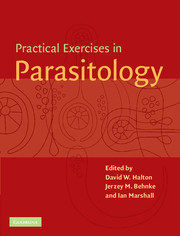Book contents
- Frontmatter
- Contents
- List of contributors
- Preface
- General advice
- 1 Observational Exercises on Parasites
- 2 Ecology
- 3 Physiology and Biochemistry
- 3.1 Hatching in vitro of oncospheres/hexacanth larvae of Hymenolepis diminuta
- 3.2 Activation of the cysticercoids of Hymenolepis species in vitro
- 3.3 Membrane transport in the cestode Hymenolepis diminuta, in vitro
- 3.4 Glycogen utilisation and deposition in flatworm parasites
- 3.5 Effects of classical transmitters on the motility of parasitic roundworms and flatworms
- 3.6 Electrophysiology of Ascaris suum body muscle
- 3.7 Immunocytochemical localisation of neuroactive substances in helminth parasites
- 4 Pathology and Immunology
- 5 Chemotherapy
- 6 Molecular Parasitology
- 7 Behaviour
- Appendix 1 Reagent index
- Appendix 2 UK suppliers
- Appendix 3 US suppliers
- Index
3.4 - Glycogen utilisation and deposition in flatworm parasites
Published online by Cambridge University Press: 05 June 2012
- Frontmatter
- Contents
- List of contributors
- Preface
- General advice
- 1 Observational Exercises on Parasites
- 2 Ecology
- 3 Physiology and Biochemistry
- 3.1 Hatching in vitro of oncospheres/hexacanth larvae of Hymenolepis diminuta
- 3.2 Activation of the cysticercoids of Hymenolepis species in vitro
- 3.3 Membrane transport in the cestode Hymenolepis diminuta, in vitro
- 3.4 Glycogen utilisation and deposition in flatworm parasites
- 3.5 Effects of classical transmitters on the motility of parasitic roundworms and flatworms
- 3.6 Electrophysiology of Ascaris suum body muscle
- 3.7 Immunocytochemical localisation of neuroactive substances in helminth parasites
- 4 Pathology and Immunology
- 5 Chemotherapy
- 6 Molecular Parasitology
- 7 Behaviour
- Appendix 1 Reagent index
- Appendix 2 UK suppliers
- Appendix 3 US suppliers
- Index
Summary
Aims and objectives
This exercise is designed to demonstrate:
Utilisation of ethanol-precipitable carbohydrate (glycogen) as an energy store in an endoparasitic flatworm (trematode or cestode), using simple spectrophotometry.
The distribution of glycogen in the various organ systems of the parasite, using histochemical procedures.
Introduction
The bioenergetic pathways of endoparasitic flatworms generally function anaerobically, with emphasis on synthetic metabolic capacities rather than complete substrate breakdown. The worms are generally facultative anaerobes, deriving their energy largely from the catabolism of glucose and glycogen and excreting highly reduced end products. In contrast to free-living organisms, terminal oxidative pathways are either absent or largely abbreviated in parasitic flatworms, precluding the use of proteins or lipids as energy sources. Thus, cestodes and most digenean trematodes have a pronounced carbohydrate metabolism. They contain and turnover large quantities of endogenous carbohydrate, have a high rate of transport of exogenous sugars into the tissues, and are known to produce substantial amounts of fatty acids in vitro. For example, the cyclophyllidean tapeworm, Hymenolepis diminuta, may contain as much as 50% of its dry weight as glycogen. When the host (rat) is deprived of carbohydrate in its diet, the glycogen content of the worm falls rapidly, and when such starved worms are given glucose in vitro, glycogen synthesis (glycogenesis) also proceeds rapidly. Similarly, the liver fluke, Fasciola hepatica, generally contains 15–20% glycogen per dry weight and under conditions of starvation uses up some 20% of this reserve within 5 h.
- Type
- Chapter
- Information
- Practical Exercises in Parasitology , pp. 201 - 208Publisher: Cambridge University PressPrint publication year: 2001



